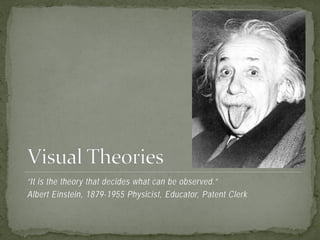
How the Brain Interprets Visual Stimuli
- 1. “It is the theory that decides what can be observed.” Albert Einstein, 1879-1955 Physicist, Educator, Patent Clerk
- 2. Prepared by Danielle Oser, APR
- 5. Concerned with what the brain sees – visual cues
- 9. Too many images to process and remember Cells note the stimulation and passes it on to your mind without considering it
- 10. Max Wertheimer German psychologist, 1910 See the scene outside although partially blocked “Flipbook” effect Eye takes in all the visual stimuli – brain arranges the sensation into a coherent image
- 14. Photomosaics by Robert Silvers
- 16. Max Weterhimer
- 21. • Objects that look similar will automatically be grouped together by the brain Dissimilarity creates visual interest
- 23. Brain more closely associates objects close together than it does an object that is farther apart
- 24. Brain seeks as much as possible a smooth continuation of a perceived movement
- 25. Also refers to objects that are partially blocked by a foreground object with a viewer’s mind continuing the line in order to achieve a kind of graphic closure
- 26. Viewers mentally group the arrows because they all point in the same direction Opposite directions create tension because the viewer will not see it as part of the group
- 31. Create more noticeable print and screen media designs
- 32. • “The Whole is Different from the Sum of its Parts” Insights can be learned when attention is turned to the entire image
- 34. Julian Hochberg, 1970 Emphasizes the viewers eye movements in an active state of perception
- 35. Eyes are constantly in motion when scanning an image Viewers construct a scene with short-lived eye fixations that the mind combines to a whole
- 36. Help designers capture attention
- 37. Content Driven
- 38. A sign is something that stands for something else The meaning behind any sign must be learned, understood
- 39. 397 CE First proposed the study of signs First to write about the link between symbolism and nature
- 40. Swiss linguist Helped establish the symbolic interpretation of signs
- 41. American Philosopher Helps establish the field of semiotics in the US Defines 3 types of signs Iconic Indexical Symbolic
- 42. Easiest to interpret Closely resemble the thing that they represent
- 44. What is the iconic sign here? Iconic signs have the strongest one-on-one connection between the image and what it represents
- 46. What is the indexical sign here? Logical, common-sense connection to the thing or idea they represent rather than a direct resemblance to the object Learn signs through everyday experiences
- 47. No logical or representational connection Must be taught Social, Cultural considerations influence symbolic signs
- 48. • Symbolic
- 49. • Symbolic
- 50. Symbols tied to religious faith often evoke the strongest emotional response
- 51. Semiotics has evolved into a theory of perception that involves the use of images in unexpected ways
- 56. What is the symbolic sign here? Hint (it’s not an image)
- 57. Example of cultural relativism Historical reference
- 59. Codes: An amalgamation of hundreds of ideas and/or elements into one convenient concept
- 60. A collection of signs that cause the viewers to make assumptions about what is seen Note our family here
- 61. Group of signs that cause the viewer to make mental comparisons
- 62. Transfer of meaning from one set of signs to another Often sexual references and “shock” ads Phallic symbols associated with alcohol, tobacco and lipstick
- 64. Several signs that combine to form a new composite message Meaning must be derived by the viewer
- 65. Music often uses several signs to create a new complex message
- 66. Signs can enhance the visual experience, educate, entertain and persuade a viewer
- 69. Our link with all the images we have ever seen Triggers memories that change the image meaning
- 70. A person’s mental state is projected onto an inanimate object or generalized statement Individuals reveal personality traits by deriving meaning from oddly formed shapes
- 71. Seeing a face or other figure in an inanimate object
- 72. Preconceived expectations about how a scene should appear often leads to false or missed visual perceptions
- 75. Did you see it?
- 76. We usually focus only on significant details within a scene
- 77. Mind ignores visual stimuli that are part of a person’s everyday activities One way to avoid habituation is to actively think about new images when one sees them
- 78. Walker Evans Series of images of common tools that demonstrated the habituation aspect of the cognitive approach
- 79. Edward Weston
- 80. A stimulus will be noticed more if it has meaning for an individual “The more you know, the more you see”
- 81. Too many competing formats create confusion, distraction Also occurs when there are too many outside stimuli Music Advertising
- 82. Criticized for having too many visual displays on the screen at one time
- 83. Culture determines the importance of the signs that affect the people who live with and among us What you notice may be a factor of race, age, gender, weight, ethnicity
- 84. We think with words Profoundly affect our understanding and recall of an image
- 85. We must look at the world closely to create designs that attract attention and be mindful of the varied messages that come from images
